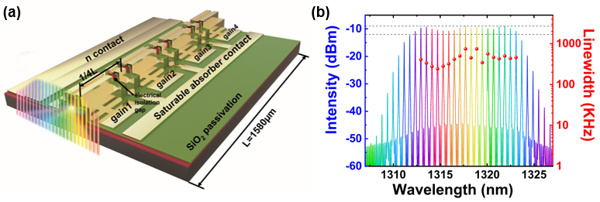Optical frequency combs (OFCs) with high frequency resolution and precision have made great progress in the recent decades and innovated the traditional spectral measurement techniques due to the coherently spaced narrow-linewidth comb lines. Recent years, OFCs have been extensively investigated in multiple application fields, such as wavelength division multiplexing (WDM) optical communications, gas sensing and detection, frequency synthesizer and atomic clocks.
However, traditional comb generation techniques are based on fiber lasers or ultra-fast lasers, which are generally bulky, expensive and power un-efficient. With the rapid development of semiconductor processing technology and nonlinear photonics, integrated OFCs appears to be a cutting-edge technology for highly coherent optical comb generation. There are three major types of integrated OFCs, which are semiconductor mode-locked lasers (MLLs), Kerr comb and electro-optic (EO) comb.
Different from the ultra-large bandwidth property of Kerr comb, semiconductor MLLs exhibit superior optical properties, such as high conversion efficiency, low power consumption and small footprint, which makes them extremely suitable for WDM transmission in applications of optical communications and optical interconnects. But conventional semiconductor MLLs suffer from relatively small comb spacing, low single channel power and narrow bandwidth, that are slowing down their progress in integration with other photonic chips.
To address the problems and drive the semiconductor MLLs based OFCs into practical applications, a joint research group led by Ting Wang, Zi-Hao Wang and Jian-Jun Zhang from Institute of Physics, Chinese Academy of Sciences reported the generation of ultra-broadband and flat-top quantum dot (QD) comb lasers with high temperature stability, great robustness and low power consumption based on the novel concept of high-order harmonic mode locking.
The new comb lasers are capable of generating narrow-linewidth optical comb at O-band with 100 GHz spacing, while the maximum operation temperature can reach over 100 oC. At room temperature, this comb laser can produce 20 comb channels with 11.5 nm bandwidth (within 3 dB), which is widest flat-top comb source reported up to date. The relevant research results were published in Photonics Research, Volume 10, No. 5, 2022 (Jing-Zhi Huang, Zi-Tao Ji, Jia-Jian Chen, Wen-Qi Wei, Jia-Le Qin, Zi-Hao Wang, Zhi-Yuan Li, Ting Wang, Xi Xiao, and Jian-Jun Zhang, Ultra-broadband flat-top quantum dot comb lasers, Photonics Research, 2022, 10(5): 1309).
In this scheme, 4th-order harmonic QD colliding pulse mode locked laser (CPML) is designed and fabricated for comb generation. The schematic of the fourth-order QD-CPML is shown in Fig. 1(a). The total distance of the laser cavity is 4 times longer than that of the two-section MLL which produces pulses with fundamental repetition rate. In order to produce 100 GHz spacing OFCs, the cavity length of the fundamental mode is calculated as ∼395 μm by using an effective group index of 3.8. Considering that QD lasers with such a short cavity may not have enough gain to support stable mode locking and decent output power, a fourth-order MLL design with 1580 μm cavity length is implemented here to allow four colliding pulses traveling intracavity to produce fourth-order harmonic pulses at 100 GHz repetition rate.

Fig.1 (a) Schematic of 4th-order harmonic mode-locked laser for comb generation. (b) Generated flat-top comb spectrum at room temperature.
Under the optimum operating condition of 224 mA injection current and -3.8 V reverse bias voltage, twenty 100 GHz spacing comb channels with 3 dB optical bandwidth of 11.5 nm are produced, as shown in Fig. 1(b). It can be clearly observed that each comb line exhibits optical signal-to-noise ratio over 35 dB. Each comb line here exhibits average optical linewidth of approximately 400 kHz and relative intensity noise of -135 dB/Hz, which are sufficient for WDM transmission. By externally modulating 20 comb lines, 70 Gbit/s NRZ and 40 Gbaud/s PAM-4 eye diagrams are demonstrated here, indicating the potential of achieving 1.6 Tbit/s transmission via single QD-CPML.
Furthermore, by further extending the optical bandwidth, we demonstrate four QD-CPMLs operating at individually selected temperature, that generating 60 comb lines with 100 GHz spacing (36 nm optical bandwidth within 3 dB). Such multiple QD-CPML combined devices could potentially produce 4.8 Tbit/s data transmission in the near future.
Compared to the traditional schemes of WDM system with multiple numbers of distributed feedback (DFB) lasers, the QD-CPML exhibit superior properties, such as low cost, low power consumption and high temperature stability, which has the potential for large-scale and low power bugget applications.
The article reports the generation of broadband flat-top optical frequency comb, which can be implemented in Tb/s transceivers and optical interconnects. Moreover, the scheme with excellent energy efficiency and temperature stability can be further applied into fields, such as integrated sensing and microwave photonics.


